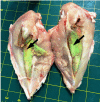The genetic basis of pectoralis major myopathies in modern broiler chicken lines
- PMID: 26476091
- PMCID: PMC4988535
- DOI: 10.3382/ps/pev304
The genetic basis of pectoralis major myopathies in modern broiler chicken lines
Abstract
This is the first report providing estimates of the genetic basis of breast muscle myopathies (BMM) and their relationship with growth and yield in broiler chickens. In addition, this paper addresses the hypothesis that genetic selection for increase breast yield has contributed to the onset of BMM. Data were analyzed from ongoing recording of BMM within the Aviagen breeding program. This study focused on three BMM: deep pectoral myopathy (DPM; binary trait), white striping (WS; 4 categories) and wooden breast (WB; 3 categories). Data from two purebred commercial broiler lines (A and B) were utilized providing greater than 40,000 meat quality records per line. The difference in selection history between these two lines has resulted in contrasting breast yield (BY): 29% for Line A and 21% for Line B. Data were analyzed to estimate genetic parameters using a multivariate animal model including six traits: body weight (BW), processing body weight (PW), BY, DPM, WB, and WS, in addition to the appropriate fixed effects and permanent environmental effect of the dam. Results indicate similar patterns of heritability and genetic correlations for the two lines. Heritabilities (h2) of BW, PW and BY ranged from 0.271-0.418; for DPM and WB h2<0.1; and for WS h2≤0.338. Genetic correlations between the BMM and BW, PW, or BY were ≤0.132 in Line A and ≤0.248 in Line B. This paper demonstrates the polygenic nature of these traits and the low genetic relationships with BW, PW, and BY, which facilitates genetic improvement across all traits in a balanced breeding program. It also highlights the importance of understanding the environmental and/or management factors that contribute greater than 65% of the variance in the incidence of white striping of breast muscle and more than 90% of the variance of the incidence of wooden breast and deep pectoral myopathy in broiler chickens.
Keywords: Broilers; breast muscle; heritability; meat quality; myopathy.
© The Author 2015. Published by Oxford University Press on behalf of Poultry Science Association.
Figures






Similar articles
-
Characterising the Influence of Genetics on Breast Muscle Myopathies in Broiler Chickens.Front Physiol. 2020 Aug 20;11:1041. doi: 10.3389/fphys.2020.01041. eCollection 2020. Front Physiol. 2020. PMID: 32973559 Free PMC article.
-
White striping and wooden breast myopathies of broiler breast muscle is affected by time-limited feeding, genetic background, and egg storage.Poult Sci. 2019 Jan 1;98(1):217-226. doi: 10.3382/ps/pey333. Poult Sci. 2019. PMID: 30101277
-
Dietary amino acids under hypoxic conditions exacerbates muscle myopathies including wooden breast and white stripping.Poult Sci. 2019 Mar 1;98(3):1517-1527. doi: 10.3382/ps/pey463. Poult Sci. 2019. PMID: 30289544
-
White striping and woody breast myopathies in the modern poultry industry: a review.Poult Sci. 2016 Nov 1;95(11):2724-2733. doi: 10.3382/ps/pew216. Epub 2016 Jul 21. Poult Sci. 2016. PMID: 27450434 Review.
-
From muscle to food: oxidative challenges and developmental anomalies in poultry breast muscle.Poult Sci. 2019 Oct 1;98(10):4255-4260. doi: 10.3382/ps/pey409. Poult Sci. 2019. PMID: 30371852 Review.
Cited by
-
Physiological and Pathological Mitochondrial Clearance Is Related to Pectoralis Major Muscle Pathogenesis in Broilers With Wooden Breast Syndrome.Front Physiol. 2020 Jun 16;11:579. doi: 10.3389/fphys.2020.00579. eCollection 2020. Front Physiol. 2020. PMID: 32612535 Free PMC article.
-
Novel Candidate Genes Involved in an Initial Stage of White Striping Development in Broiler Chickens.Animals (Basel). 2024 Aug 16;14(16):2379. doi: 10.3390/ani14162379. Animals (Basel). 2024. PMID: 39199913 Free PMC article.
-
Genetic parameters of white striping in relation to body weight, carcass composition, and meat quality traits in two broiler lines divergently selected for the ultimate pH of the pectoralis major muscle.BMC Genet. 2016 Apr 19;17:61. doi: 10.1186/s12863-016-0369-2. BMC Genet. 2016. PMID: 27094623 Free PMC article.
-
Factors Affecting Breast Myopathies in Broiler Chickens and Quality of Defective Meat: A Meta-Analysis.Front Physiol. 2022 Jul 1;13:933235. doi: 10.3389/fphys.2022.933235. eCollection 2022. Front Physiol. 2022. PMID: 35846009 Free PMC article.
-
Colonization of a commercial broiler line by Campylobacter is under limited genetic control and does not significantly impair performance or intestinal health.Poult Sci. 2018 Dec 1;97(12):4167-4176. doi: 10.3382/ps/pey295. Poult Sci. 2018. PMID: 29982748 Free PMC article.
References
-
- Al-Musawi S. L., Stickland N. C., Bayol S. A. M. In ovo temperature manipulation differentially influences limb musculoskeletal development in two lines of chick embryos selected for divergent growth rates. J. Exp. Biol. 2012;215:1594–1604. - PubMed
-
- Alnahhas N., Berri C., Boulay M., Baeza E., Jego Y., Baumard Y., Chabault M., Le Bihan-Duval E. Selecting broiler chickens for ultimate pH of breast muscle: analysis of divergent selection experiment and phenotypic consequences on meat quality, growth, and body composition traits. J. Anim. Sci. 2014;92:3816–3824. - PubMed
-
- Bianchi M., Petracci M., Franchini A., Cavani C. The occurrence of deep pectoral myopathy in roaster chickens. Poult. Sci. 2006;85:1843–1846. - PubMed
-
- Bilgili S. F., Hess J. B. Aviagen Brief, March. Huntsville, AL: Aviagen; 2008. Green Muscle Disease - Reducing the incidence in broiler flocks; p. 4. 35811.
MeSH terms
LinkOut - more resources
Full Text Sources
Other Literature Sources
Medical

